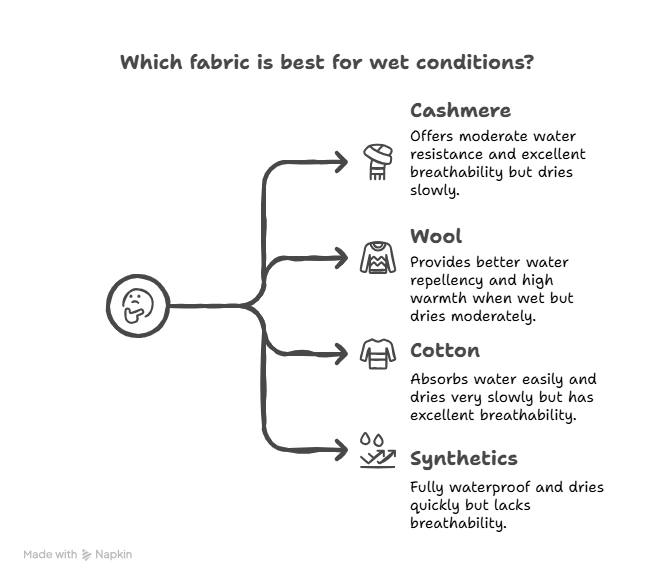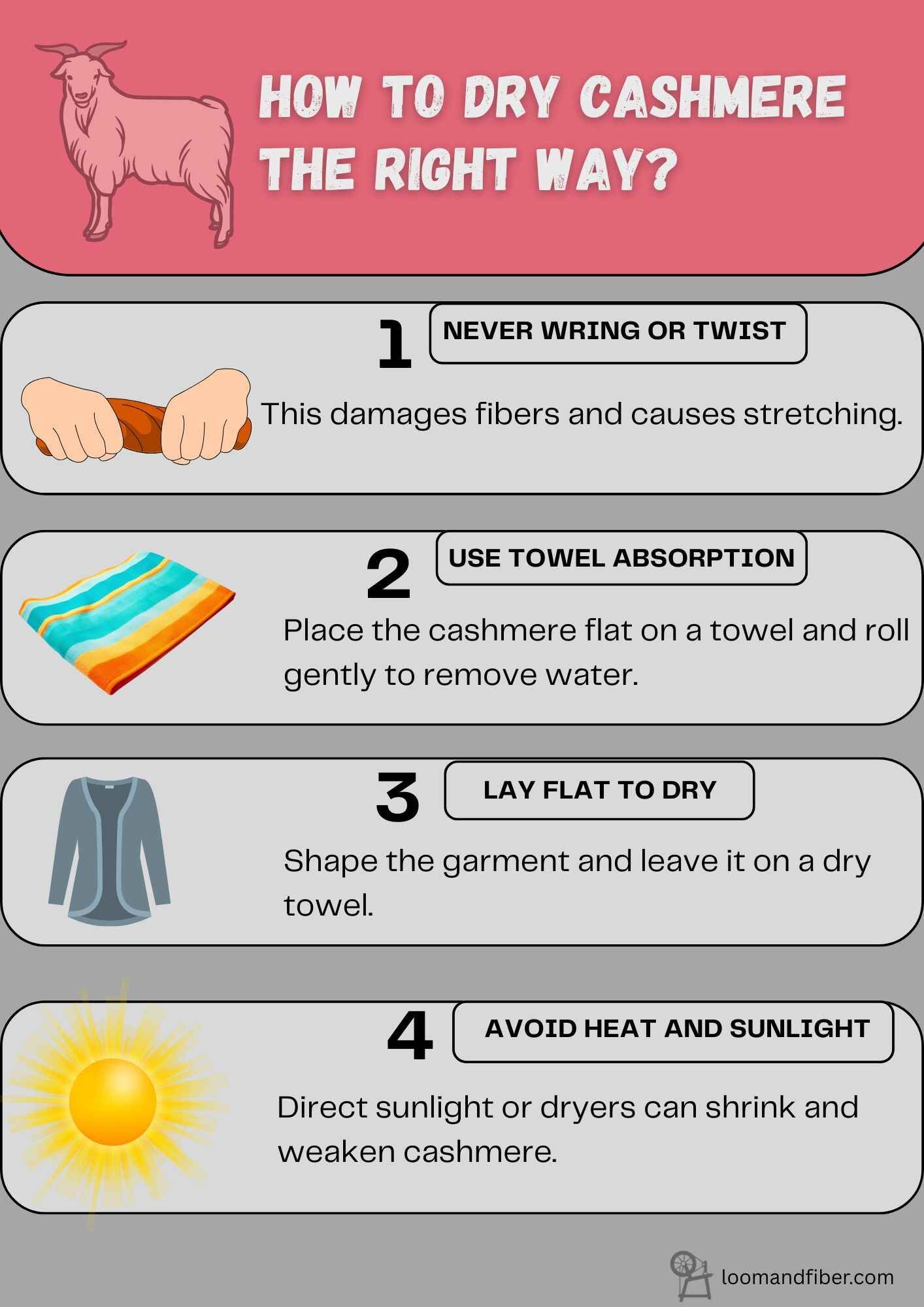Introduction: Why People Ask if Cashmere is Waterproof
Cashmere is not merely a cloth, it is the symbol of beauty, coziness, and high-class. Cashmere garments are investment pieces known to be very buttery warm. But there is a general question that usually asks buyers, Is cashmere waterproof?
The question that is often asked is whether people can wear cashmere during light rain or snow without ruining it. And all the same, when you are spending a lot of money on a cashmere sweater or scarf, it does matter to have that invested money safeguarded.
Here we will establish the answer to the question of whether cashmere is waterproof, discuss its response to moisture, and offer some tips to help you keep it looking beautiful forever.
Is Cashmere Waterproof?
Cashmere is not waterproof. It does not have any special coating or wax to keep off the water as in technical rainwear. Cashmere is, however, a natural fiber which is slightly water-repellent at the outset. The cashmere fibers are able to absorb water (as much as roughly 30 percent of their weight) without instant moistness, and thus some droplets may seep onto the surface in the short term. Conclusively, cashmere is no different than wool in that it will get wet during rain and therefore, it should be treated with care and left to dry.
How Cashmere Reacts to Water
Absorption properties of natural fibers
Cashmere (goat undercoat fiber) is hygroscopic: it is easy to absorb moisture vapor and has the ability to retain up to about 30 percent of its own weight in water. This is because cashmere is able to absorb humidity or dampness without the feeling that it is being drenched immediately. It can even evaporate the heat when moisture is taken into the fibers and condenses. Nevertheless, cashmere has a smooth surface which is not very scaly and thus the liquid water enters into the fiber. On the whole, cashmere is going to gradually absorb water (a bit like wool) instead of repelling it.
What happens when cashmere gets wet
When wet, the cashmere garment absorbs a lot of the water. The wet fibers are heavier and they may significantly lose the insulating ability temporarily as the trapped water heats the body. Notably, the fibers of cashmere swell and get heavier when wet. The most important thing is to take care, when a cashmere sweater is caught in rain, it is better to lay it flat to dry, it will be soft and corrected. Otherwise, a lack of drying or washing properly will lead to issues (see next).
Can cashmere shrink, stretch or lose softness
Shrinkage and softness: Cashmere has the ability to shrink or felt when exposed to water and heat or friction. That is, wet cashmere can be readily shrunk during agitation or poor washing. It will also lengthen or bend when it is merely dripping when hanging. Shaping: damp cashmere must not be wringed or twisted, this is likely to stretch the fine fibers. When dried well it will be soft. Loss of softness: Wet cashmere can be made to seem coarse or stiff during rough handling (e.g. machine drying or wringing).
Is Cashmere Water-Resistant?
Natural fiber oils and lanolin
Cashmere goats also do not produce much lanolin, the natural oil that makes wool water-resistant unlike the wool of a sheep. This is therefore not a natural hydrophilic coating that Cashmere has. The smooth surface of the fiber does not have a substantial obstacle to the water droplets. Nevertheless, despite the absence of lanolin, the fine fibers of the cashmere may occasionally drop small drops in a very short time (the structure of the cashmere fabric consists of air pockets and thick wool-like undercoat). Practically, cashmere is pleasant in a light dampness, but does not actually repel water.
Suitable for light drizzle or snow
Cashmeres can withstand a light or small snow or rain. A cashmere sweater in a light snow or short drizzle can only become a bit wet on the face, and the user is still warm. This is because the fiber is lofty and insulating: although a little wet, the air in the threads will keep it warm. Hence, you can escape with a couple of few minutes under wet wind or light snow with money stored in cashmere. All you have to do is keep it wet the longer it is wet the more it will soak through.
Not recommended for heavy rain or soaking
Cashmere will never keep you dry in the rain or long and wet periods. Being completely unfinished, it absorbs water like any normal wool. Cashmere clothes will be heavy and chilled when they are soaked. Concisely: cashmere is not water-resistant even under very light precipitation. A raincoat or umbrella is necessary in the case of any serious rain or snowstorm since cashmere is not capable of remaining dry.
What Happens If Cashmere Gets Wet?
- Does it shrink? Yes. Wet cashmere may shrink when it is treated roughly or dried badly. Never leave the bottom of the bath and refold in cold water during drying or it will become flattened.
- Does it lose shape? It can. During the rainy season, cashmere can be lengthened when fully wet, particularly in the sleeves or hem. Cashmere does not keep its shape when wet and therefore you should reform it when it is wet.
- How long does it take to dry? Cashmere naturally dries slowly. Depending on thickness and climate, it can require 24 48 hours (or longer). Place it lying on a flat surface in an airy place. It can be air-dried, in reality, tumble drying is not a good idea. A light sweater made of wool could be dried in a night, and a mass of cashmere coat could require one day or two.
- Does it lose softness? Only if mistreated. Provided you take gentle treatment, cashmere does not permanently become hard just because it becomes damp. This is primarily incorrect drying: machine-drying or vicious spinning may cause it to become rigid or coarse. Wash with hands or soak and dry in the air to maintain the fibers to be silky.
Cashmere vs Other Fabrics in Wet Conditions

Cashmere vs Wool:
They are both animal fibers, and keep warm. Wool (e.g. of sheep, wool, i.e. merino) has lanolin and is able to absorb almost 30 percent of its weight of water and remain warm. It also emits warmth because it absorbs moisture. Cashmere is a more delicate warm fabric and it does not contain lanolin. Wool is far more effective as a thermal resistant fabric when damp than cotton or synthetics are. Cashmere would not be very durable in the wet weather, though it would be warmer than wool.
Read More>> About cashmere vs. merino.
Cashmere vs Cotton:
Cotton is a spongy water absorbent. A wet cotton sweater is cold and heavy, as moist cotton loses the majority of insulation. Cashmere on the contrary wicks and dries quicker than cotton. Cashmere also remains warmer than cotton in case you are caught in a sprinkle, and will not stick to your body when wet. Cotton does not work well in the wet season; cashmere works (but none is waterproof).
Cashmere vs Synthetics (polyester, nylon):
Synthetics are usually easy to shed and very quick to dry up hence they are essentially water resistant. They are however not insulated when wet and may become perspirous. Polyester or nylon are not ruined by water, and are not insulated or breathed so well as cashmere. Synthetics in wet weather will keep you dry though not always warm, and cashmere will keep you warm though not dry. Synthetics hold odors and static and cashmere is soft and odorless even after getting wet.
| Fabric | Water Absorption | Warmth When Wet | Breathability/Comfort |
|---|---|---|---|
| Cashmere | Absorbs moisture (~30% of weight) | Moderately warm; may cool as fibers wet up | High breathability and natural softness |
| Wool (sheep) | Absorbs ~30% of weight | Remains warm; even releases heat when wet | High; thermoregulating fiber |
| Cotton | Absorbs a lot; stays wet (hydrophilic) | Cools quickly; heavy and clings when wet | Moderate; breathable but feels damp |
| Synthetic (polyester, nylon) | Repels water; dries rapidly | Poor insulation; feels cold without warmth | Low; can trap odor and static, less comfy |
Can Cashmere Be Made Waterproof?
Waterproofing sprays and treatments
Yes – sort of. Cashmere is waterproofed with a spray (such as Scotchgard or Nikwax) that coats the fibers. These sprays provide an invisible lining on fabric to be repulsive to water. The other technique is lanolizing: placing the garment in the solution of lanolin. The oil that causes wool to withstand moisture is Lanolin. When you lay down a small coat of water-repellent applications on cashmere, you are introducing a little waterproof liner to the garment. Note: These treatments alter the feel a little, hence, try it on an old one.
Blended cashmere fabrics
Alternatively one can use cashmere blends. Several of the luxury coats or sweaters contain a combination of cashmere with synthetic (e.g. cashmere-wool blend or cashmere-cotton with a waterproof layer). Water resistance and durability can be enhanced by simply adding 5 to 15 percent synthetic such as nylon. There are cashmere jackets of high-end design that are combined with a water-proofing element. A pure cashmere knit cannot be waterproof, whereas a mixed blend will help to avoid moisture more and preserve the softness of cashmere.
Using protective outer layers
The most basic is the strategy of layering. Wear cashmere as the layer of inner warmth and always wear a waterproof jacket or coat on top during the wet weather. Heavy lifting is done by a trench coat, rain jack or umbrella. As an illustration, when you are wearing your cashmere sweater, you can wear it under a raincoat to keep it dry. This will save cashmere the inconvenience of getting wet in the rain. In brief, cashmere should insulate, your outer-garments should waterproof.
How to Care for Wet Cashmere

- Reshape and blot: In case of a wet cashmere blot on a clean towel will help to remove moisture. Do not rub or wring. Place the item on the towel that is dry. Then refold it (patters, sleeves, edges) back to its shape. This ensures that there is no sagging or distortion during drying. The wet sweater should always be handled carefully.
- Dry correctly: Cashmere can be laid flat to dry and aired, but not in the direct heat or the sun. Hang not, tumble-dry not – gravity and heat may lengthen or shorten it. Instead, roll a towel: roll the garment in a dry towel and roll it under to remove the excessive water then place it on a flat surface. Make it flat so that it dries evenly.
- Long-term care: Place cashmere folded, not using hangers, to maintain its shape. Refresh without washing: dry clean cashmere between the wears to give it a fresh smell. In laundering, cold water and soft detergent should be used. Periodically it can be lanolized: Lanolin treatment will revive natural water repellency (as with wool). Wash or comb on delicacy cycle periodically to ensure that the fibers are fluffy.
Best Situations to Wear Cashmere
Everyday Wear in Cool and Dry Climate
Cashmere is comfortable during cool dry seasons. It maintains temperatures effectively to ensure that you are not too warm.
Light Winter Layering
Undercoats or jackets made of cashmere are good insulating layers. It suits the slightly cold days or indoor winter.
Not to get Wet or Moist
Wet and rain loosen the fibers and influence the texture. Waterproof outerwear should always be worn in case of probability of exposure to moisture.
FAQs
Not really. Cashmere is a great insulator but is not something that should be used in rains or the wet season. It dries fast and this can in turn make it lose its shape and warmth. It is best to always wear it under a waterproof or water-proof coat.
Yes, cashmere may shrink in case it is soaked and subjected to bare heat or motion. The fine fibers tighten and the garment is left without the initial size and feel. To avoid shrinkage, it should always be air dried in a flat towel besides sunlight or heaters.
Cashmere can be worn in light dry snow, yes, as it provides light yet warm and breathable coverage. Nevertheless, do not use in wet or slushy snow, as the liquid can saturate the fibers and then they get heavy. Cashmere items should always be covered with a waterproof outer covering
A wool-safe waterproofing spray that is specific to delicate fibers can be used. These sprays create a thin layer against moisture without changing the texture or softness. To protect yourself further, put on cashmere under a trench coat or a jacket that keeps off the rain.
Not necessarily. Cashmere can be restored to its natural softness and shape when dried. The trick here is to squeeze out all the surplus water, refold and allow it to dry on its own natural way–under no circumstances should it be wringing, twisting, or subjected to direct sources of heat.
Conclusion-
So, is cashmere waterproof? The answer is clear — no, it’s not. Nevertheless, it has natural fibers that offer a limited amount of water resistance which shields it temporarily against light rain.
In order to ensure your cashmere clothes stay beautiful over the years, do not expose them to heavy rain and do not dry them on a dryer in case they become wet. Cashmere is most wisely matched with waterproof outerwear in order to be fashionable, warm and dry.
Finally, cashmere is a luxurious, warm but soft fiber. By being conscious, you are able to enjoy its unsurpassed softness and beauty without having to be concerned about being harmed by water. Use it as an investment piece and it will pay ample dividend in the form of a classic comfort and beauty.
Read More>> About what is cashmere made from?
